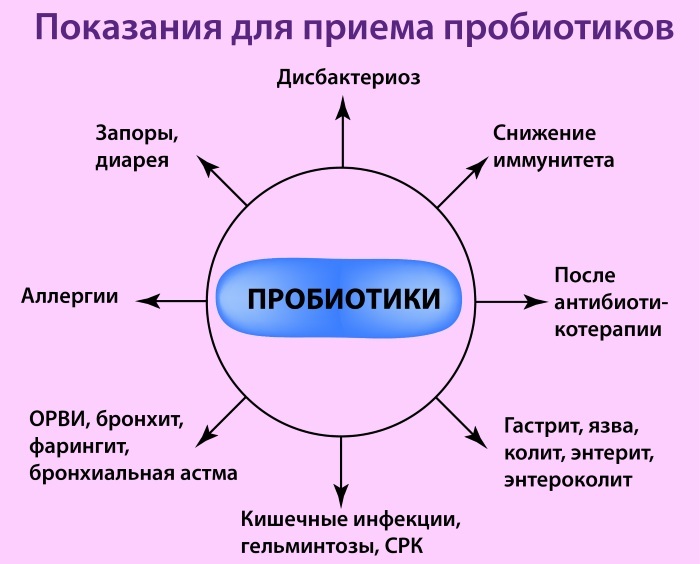For effective treatment and prevention development of tuberculosis phthisiatricians prescribe various anti-tuberculosis drugs to patients. In pharmacology, these drugs are divided into medicines of 1, 2 and 3 rows.
The principle of action and effectiveness of drugs have their own differences. The 1st row includes drugs that can reduce the activity of mycobacteria with minimal negative consequences for the patient's body.
In case of ineffectiveness of these medicines, the doctor prescribes drugs of the 2nd row, which are less active on the causative agent of tuberculosis and are characterized by high toxicity. In pharmacology, there are also 3-line drugs (reserve funds) that are effective in the resistance of Koch's bacillus to drugs of the 1 and 2 lines.
Only a qualified phthisiatrician can prescribe an appropriate treatment regimen and determine the dosage. Self-medication of tuberculosis is fraught with various complications, deterioration in the quality of life, and death.
Record content:
- 1 Classification
-
2 Top 10 drugs from the pharmacy
- 2.1 Ofloxacin
- 2.2 Levofloxacin
- 2.3 Thioacetazone
- 2.4 Ethionamide
- 2.5 Streptomycin
- 2.6 Rifampicin
- 2.7 Ethambutol
- 2.8 Prothionamide
- 2.9 Amikacin
- 2.10 PASK
- 3 Tuberculosis treatment video
Classification
TB drugs of the 1st line are prescribed by phthisiatricians most often, since they are easier to tolerate by the patient's body, and the likelihood of adverse reactions is minimized. The principle of classification of medicines depends on the indicator of their activity in relation to mycobacteria (Koch's bacillus).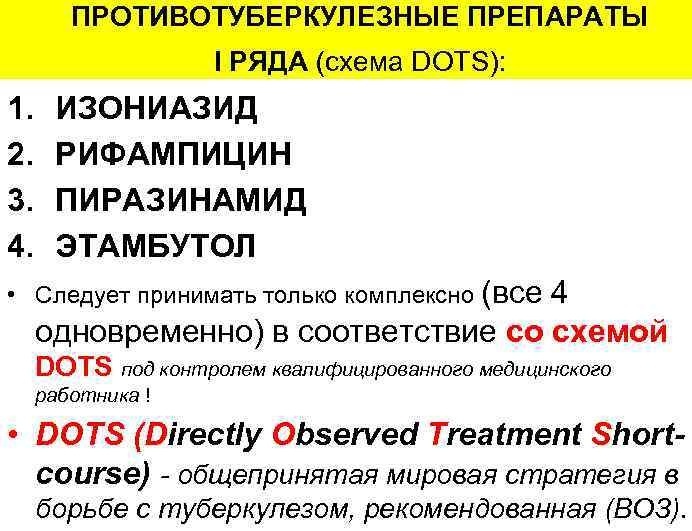
| Medicines | Description | Drug names |
| 1 row | These are the most effective and popular medicines with which you can get rid of an infectious disease. | Pyrazinamide, Ethambutol |
| 2 row | The use of drugs from this category is justified in the case when the mycobacteria detected in the patient's body turned out to be resistant to anti-tuberculosis drugs of the 1st line. | Cycloserine, Prothionamide, Capreomycin |
| 3 row | In pharmacology, these drugs are called reserve drugs. The drugs have a less intense effect on mycobacteria than drugs of the 1st and 2nd row. Medicines are highly toxic. | Thioacetazone, PASK, Clarithromycin |
| Combined | The effectiveness of medicines is due to the presence of several antibacterial components in the composition at once. | Phtizoetam B6, Zukoks, Rifater, Laslonvita, Forcox |
| New generation anti-tuberculosis drugs | These drugs are still under development, which is why they have not yet received a lot of reviews. Some patients claim that after 2-3 months of regular use of new generation drugs, they managed to get rid of tuberculosis. | Sirturo, Perchlozone, Mycobutin |

Anti-tuberculosis drugs of the 1st line are prescribed by phthisiatricians if the patient has an infectious disease of any localization.
For example:
- Tuberculous intoxication.
- Primary tuberculosis complex.
- A positive reaction of the skin to tuberculin.
- Pulmonary tuberculosis.
- Tuberculous meningitis.
- Tuberculous lesions of the skin, kidneys, genitourinary system, bone tissue.
- Tuberculosis of the peritoneum, intestines, lymph nodes.
Medicines are allowed to be used to prevent the development of an infectious disease. A phthisiatrician can prescribe a drug to those who have been in contact with a patient who has an open form of tuberculosis.
Top 10 drugs from the pharmacy
In traditional medicine, there are different categories of medicines that are intended for the prevention and treatment of tuberculosis. Drug therapy can be carried out using ASD (Dorogov's antiseptic stimulator). After a full examination of the patient's body, the phthisiatrician determines the diagnosis and prescribes a treatment regimen, dosage drugs, due to which the likelihood of a complete cure from a dangerous infectious diseases.
Ofloxacin
This antibiotic belongs to the category of fluoroquinols. Ofloxacin is used to treat multidrug-resistant tuberculosis. The drug will be included in the complex drug therapy.
The principle of action of the drug is based on the blockade of the enzyme DNA gyrase. The drug is available in the form of a solution for infusion, eye ointment, tablets. Ofloxacin is used as an active ingredient.
The tablets additionally include:
- Corn starch.
- Microcrystalline cellulose.
- Calcium and magnesium stearate.
- Colloidal silicon dioxide.
- Talc.
- Low molecular weight polyvinylpyrrolidone.
The drug helps to cope with infectious diseases of the respiratory tract, skin, soft tissues. The active component of the drug is effective for gonorrhea, gynecological pathologies. Phthisiatricians include ofloxacin in the complex therapy of tuberculosis.
The tablet form of the drug is taken orally at 200-800 mg 2 times a day. The duration of treatment depends on the sensitivity of Koch's bacillus and the general clinical picture. After the disappearance of the symptoms of tuberculosis and the normalization of body temperature, the patient must take the medicine for another 3 days.
Ofloxacin is prohibited from using those patients who have an individual intolerance to the constituent components. The drug is contraindicated in epilepsy, glucose-6-phosphate dehydrogenase deficiency, a decrease in the seizure threshold and tendon damage.
The medicine can be prescribed with caution to those patients who have been diagnosed with circulatory disorders in the brain, vascular atherosclerosis, acute renal failure.
In isolated cases, the use of the drug can provoke the occurrence of the following adverse reactions:
- Hypoglycemia.
- Myalgia.
- Tachycardia, a decrease in blood pressure indicators.
- Confusion of consciousness.
- Violation of color perception.
- Nausea, vomiting.
- Aching pain in the epigastric region.
- Allergic skin rash.
- Limb tremor.
- Migraine.
If the patient takes a large dose of the drug, then he may experience: disorientation, vomiting, stool disturbance and drowsiness. To normalize the patient's well-being, the patient needs to rinse the stomach and seek qualified help from a doctor, who, if necessary, will prescribe effective symptomatic treatment. Ofloxacin is sold by prescription. The cost of the medicine is in the range of 55-180 rubles.
Levofloxacin
It is a powerful synthetic broad-spectrum antibiotic that has a detrimental effect on Koch's bacillus. Drug resistance is extremely rare and slow to form. This drug can be used in patients over 18 years of age.
Otherwise, the components of the drug can adversely affect the condition of the child's joints. The active ingredient of the drug is levofloxacin. The medicine is available in the form of eye drops, tablets and intravenous solution.
The tablet form of the drug contains the following auxiliary components:
- Titanium dioxide.
- Microcrystalline cellulose.
- Calcium stearate.
- Croscarmellose sodium.
- Hypromellose.
- Iron oxide is yellow.
- Macrogol.
The drug is indicated for infectious and inflammatory diseases that are provoked by mycobacteria.
Among the main indications for the use of Levofloxacin are:
- Uncomplicated urinary tract infections.
- Acute sinusitis.
- Intra-abdominal infection.
- Exacerbation of chronic bronchitis.
- Septicemia.
- Infections of soft tissues and skin.
- Prostatitis.
- Tuberculosis.
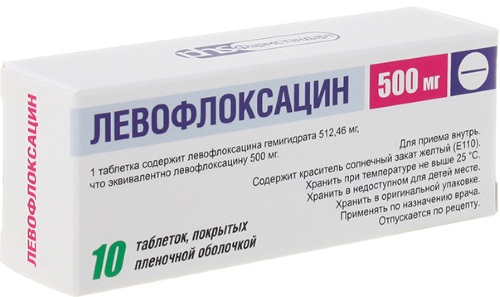
The drug is prohibited for use during pregnancy and breastfeeding. Contraindications also include epilepsy, acute renal failure.
Against the background of the use of Levofloxacin, the patient may experience the following side reactions:
- Nausea, vomiting.
- Sleep disturbance.
- Decrease in the total number of leukocytes in the blood.
- Redness of the skin.
- Increased fatigue.
- Confusion of consciousness.
- Decrease in blood pressure indicators.
For effective treatment of tuberculosis, Levofloxacin is recommended to take 1 tablet in the morning and in the evening. The duration of treatment is 3 months. Drug therapy should not be interrupted. If the patient missed taking the pills, then he should immediately take the required dosage of the drug and continue treatment in the same regimen.
In case of an overdose of the drug, the occurrence of undesirable reactions from the nervous system is possible: confusion, convulsions, dizziness. In isolated cases, patients are worried about disorders in the work of the organs of the gastrointestinal tract, erosive lesions of the mucous membranes. The drug is sold only with a doctor's prescription. Levofloxacin costs from 118 to 190 rubles.
Thioacetazone
Anti-tuberculosis drugs of the 2nd row effectively cope with Koch's bacillus, which is the causative agent of tuberculosis. The drug Thioacetazone is prescribed when mycobacteria have shown their resistance to drugs of the 1st line.
The medication is available only in tablet form. The active ingredient of the drug is thioacetazone. Phthisiatricians prescribe Thioacetazone to those patients who have been diagnosed with tuberculosis of the serous and mucous membranes, scrofuloderma, lymphadenitis or specific fistulas.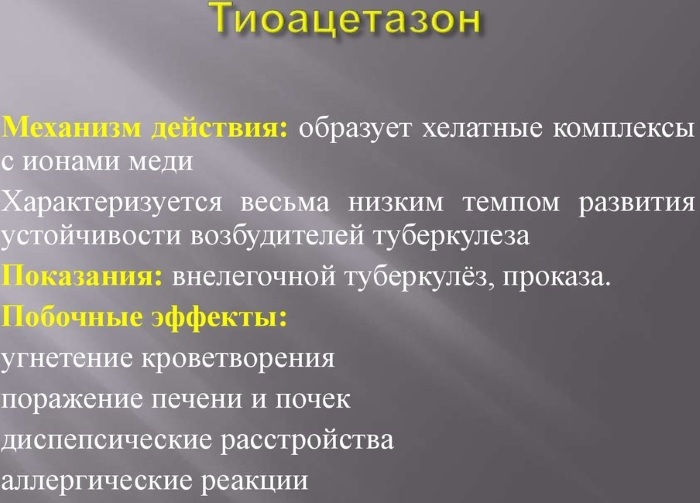
The drug is prohibited to take in case of renal failure, inhibition of bone marrow hematopoiesis. The drug is recommended to be taken orally after meals with a sufficient amount of still water. The daily dose should be between 0.1 and 0.15 g.
For children, the dosage should be reduced to 0.5-1 mg / kg body weight. The duration of treatment depends on the patient's condition and the form of the diagnosed pathology.
In isolated cases, the following side reactions may occur:
- Nausea, vomiting.
- Aching headache.
- Decreased appetite.
- Cylindruria.
- Anemia.
- Thrombocytopenia.
- Hepatitis.
- Liver dysfunction.
- Renal failure
- Allergic reaction.
In 97% of all cases, Thioacetazone is well tolerated by the patient's body. But the manufacturer of the medicinal product admits that due to significant exceeding the permissible dosage of the patient may be disturbed by the following symptoms:
- Stool disorder.
- Migraine.
- Vomit.
- Tachycardia.
- Insomnia.
- Confusion of consciousness.
- Increased body temperature.
- Quincke's edema.
If symptoms of an overdose occur, the patient should stop taking the drug and wash out the stomach. To improve your well-being, it is recommended to take activated charcoal and seek advice from a phthisiatrician in order to choose a safe analogue with him. The medicine can only be purchased with a prescription. Packaging of the drug costs from 350 to 495 rubles.
Ethionamide
It is a highly effective drug for pulmonary tuberculosis. The drug has a bacteriostatic effect, as it helps to suppress the synthesis of MBT peptides. The medicine is available in tablet form. 1 tablet contains 250 mg of ethionamide, which is an active ingredient. The drug is prescribed for pulmonary tuberculosis, MAC infection, leprosy.
Contraindications for use:
- Diabetes.
- Severe liver failure.
- Children's age (up to 14 years old).
- The period of bearing the child, lactation.
- Hypersensitivity of the body to ethionamide.
The anti-tuberculosis drug should be taken in the morning, at lunchtime and in the evening for 0.5-1 g. For the treatment of children from 14 years of age, the dosage should be reduced to 20-40 mg / kg of body weight. The child should take the medicine in the morning and in the evening. Ethionamide belongs to the 2nd row of anti-tuberculosis drugs. Before using the medicine, a mandatory consultation with a phthisiatrician is required.
Side effects:
- Hypoglycemia.
- Hypothyroidism
- Stomatitis, metallic taste in the mouth.
- Nausea, vomiting.
- Stool disorder.
- Aching pain in the epigastric region.
- Liver dysfunction.
- Optic neuritis.
- Deterioration of the emotional state.
- Migraine.
In the case of a large dose of the drug, the patient may experience vomiting, diarrhea, tachycardia. In isolated cases, arterial hypertension and urticaria may occur. The drug is sold by prescription. The cost of Ethionamide varies from 45 to 98 rubles.
Streptomycin
The drug acts on the patient's body bacteriostatically. The drug is available in the form of a powder for injection. The medicine contains 0.5 or 1 g of the active ingredient - streptomycin sulfate.
Streptomycin is effective for tuberculosis of various localization, venereal granuloma, tuberculous meningitis and urinary tract infections. When used correctly, the medicine helps to cope with endocarditis, brucellosis, intestinal infections and tularemia.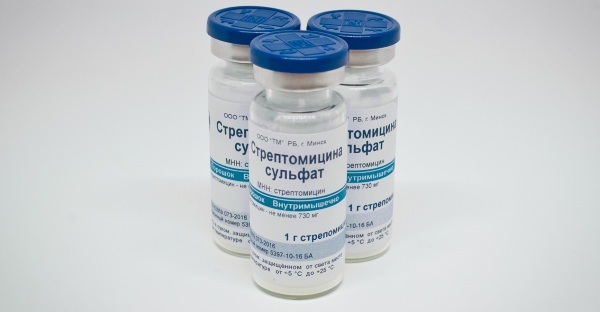
The medicinal product must not be used in the presence of the following diseases and conditions:
- The period of bearing a child.
- Individual intolerance to aminoglycosides.
- Severe kidney pathology.
- Defeat of 8 pairs of cranial nerves of an organic nature.
- Azotemia.
Streptomycin with caution can be prescribed for botulism, obliterating endarteritis, myasthenia gravis and Parkinson's disease.
If the recommendations of the attending physician are not followed, the patient may experience the following side reactions:
- Neuritis of the facial nerve.
- Sleep apnea (stopping breathing).
- Vomit.
- Increased liver enzymes.
- Diarrhea.
- Decreased hearing.
- Loss of appetite.
- Polyuria.
- Hyperemia of the skin.
- Angioedema.
- Discoordination of movements.
To achieve a positive therapeutic effect, the drug is recommended to be administered at 0.5-1 g per day. The maximum daily dosage is 2 g. The solution must be prepared immediately before administration. Streptomycin is diluted in injection water, Novocaine solution or sodium chloride solution. It is strictly forbidden to exceed the permissible dosage.
Otherwise, the following overdose symptoms may occur:
- Short-term hearing loss.
- Ataxia.
- Vomiting, nausea.
- Violation of urination.
- Dizziness.
Streptomycin is sold by prescription. The drug costs from 21 to 69 rubles.
Rifampicin
This drug helps to cope with the extracellular and intracellular forms of bacteria. Rifampicin has a positive effect on slowly growing forms that are located inside caseous necrosis. The drug is rapidly absorbed and excreted through the bile into the intestines. The drug can stain biological fluids (for example, saliva, tears) in a light pink color.
Rifampicin is available in the form of capsules and solution for infusion. 1 ampoule contains from 150 to 600 mg of an active ingredient - rifampicin. Used as auxiliary components: sodium sulfite and ascorbic acid.
The drug is indicated for MAC infection, tuberculosis and tuberculous meningitis, osteomyelitis and pyelonephritis. For effective treatment of tuberculosis, patients weighing 50 kg or more should use 600 mg of the drug once a day. If the patient's weight is less than 50 kg, then the dosage should be reduced to 450 mg. The duration of treatment is 6 to 12 months.
Rifampicin should not be used if you have the following diseases and conditions:
- Chronic renal failure.
- Individual sensitivity of the body to the components of the drug.
- Pulmonary heart failure 1 and 2 degrees.
- Jaundice.
- Infectious hepatitis.
- Lactation.
- Children's age (up to 3 years old).
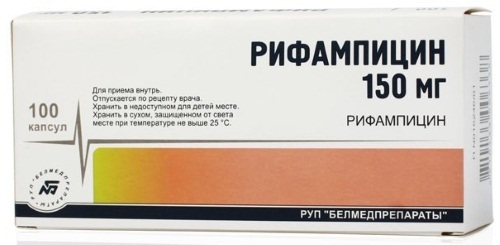
The use of a large dose of the drug is fraught with the occurrence of bronchospasm, interstitial nephritis, ataxia, angioedema. You can buy Rifampicin only with a doctor's prescription. The medicine costs from 375 to 495 rubles.
Ethambutol
The anti-tuberculosis drug is available in tablet form. The composition of 1 tablet contains the active substance ethambutol at a dosage of 100-1000 mg.
The drug is effective in all forms of tuberculosis. Ethambutol is contraindicated in gout, cataracts, optic neuritis and diabetic retinopathy. The drug should be taken orally once a day at 15 mg / kg of the patient's body weight. Treatment should last at least 2 months.
In isolated cases, the following side reactions may occur:
- Itching, burning of the skin.
- Violation of color perception.
- Decreased visual acuity.
- Peripheral neuritis.
- Migraine.
- Paresthesias in the limbs.
- Increased liver enzymes.
- Gastralgia.
In case of an overdose, the patient will experience nausea, vomiting, hallucinations and polyneuritis. In this situation, the patient should stop taking the drug and seek qualified help from a phthisiatrician, who will prescribe effective symptomatic therapy. To buy a drug, you need a doctor's prescription. The drug costs from 203 to 890 rubles.
Prothionamide
Second-line anti-tuberculosis drugs help disrupt the metabolism inside mycobacteria. Prothionamide slowly penetrates into the tissues of organs, spreads evenly throughout the body, and the main part of the drug is inactivated by the liver. The medicine is not combined with alcoholic beverages and drugs that lower blood pressure.
The medicine is available in the form of tablets, each of which contains 250 mg of prothionamide. The drug is recommended for use in tuberculosis: ulcerative, extrapulmonary, pulmonary forms.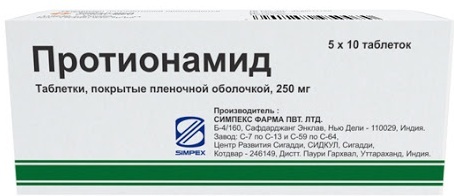
The drug is effective in the resistance of the pathogenic microflora to anti-tuberculosis drugs of the 1st line. Prothionamide is contraindicated in acute gastritis, liver cirrhosis, gastric ulcer and duodenal ulcer.
The drug should be taken in the morning, at lunchtime and in the evening for 0.5-1 g. Treatment should start with 250 mg of the drug with a gradual increase in dosage (+250 mg daily). The maximum daily dose is 750 mg.
Treatment should last 8-9 months. In medical practice, no cases of overdose with the drug Protionamide have been recorded. You need a prescription to buy the drug. A pack of 50 tablets costs from 218 to 450 rubles.
Amikacin
It is an effective semi-synthetic antibiotic that works well against mycobacteria. The medicine has a bactericidal and bacteriostatic effect on the patient's body. A high concentration of the drug in the blood is recorded within 12 hours.
Amikacin is available in the form of a powder for solution preparation, which is intended for intramuscular or intravenous administration. Amikacin sulfate is used as an active ingredient. Excipients: sodium hydrogen phosphate, disodium edetate.
Indications for use:
- Tuberculosis.
- Respiratory system infections.
- Sepsis.
- Abdominal infections.
Amikacin is contraindicated during pregnancy and lactation, as well as in inflammation of the auditory nerve and severe kidney damage. For the treatment of adults and children over 1 month old, you need to use 5 mg / kg of the patient's weight 3 times a day.
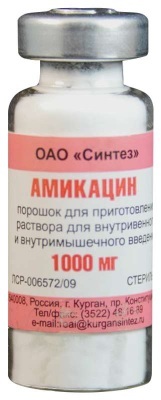
Treatment should last at least 10 days. In isolated cases after application medication the patient may experience the following adverse reactions:
- Leukopenia.
- Nausea, vomiting.
- Migraine.
- Short-term hearing loss.
- Itching, burning of the skin.
- Hyperbilirubinemia.
- Thrombocytopenia.
If the permissible dosage of the drug is exceeded, the following may occur: ataxia, migraine, Quincke's edema and tachycardia. Hemodialysis is used to effectively relieve disturbances in neuromuscular transmission. The purchase of the drug is allowed only with a prescription. The price of 1 ampoule of Amikacin varies from 126 to 340 rubles.
PASK
To effectively combat tuberculosis, a phthisiatrician may prescribe paraaminosalicylic acid (PAS). This drug helps to fight Koch's bacillus. The drug is available in the form of tablets, granules for the preparation of oral solution, powder for injection.
The composition of the medicinal product includes:
- Sodium aminosalicylate dihydrate.
- Magnesium hydroxycarbonate.
- Microcrystalline cellulose.
- Aerosil.
- Talc.
- Povidone.
- Triethyl citrate.
- Copolymer of methacrylic acid.
- Titanium dioxide.
PASK is often included in the complex therapy of various forms of tuberculosis. The drug is contraindicated in those patients who have been diagnosed with hepatitis, gastric ulcer, enterocolitis in the acute stage.
PASK belongs to the 3rd row of anti-tuberculosis drugs. The tablets must be taken orally after 1 hour. after meals, drinking plenty of alkaline mineral water. The dosage for adult patients is 9-12 g / day (the medicine should be divided into 3 doses). For the treatment of children, the dose of the drug should be reduced to 2 g / kg of body weight.
The duration of treatment is determined on an individual basis. A significant excess of the permissible dosage is fraught with the occurrence of vomiting, diarrhea and drowsiness. You can buy PASK only with a doctor's prescription. For a pack of 100 tablets, you will have to pay from 2,500 to 3,400 rubles.
Tuberculosis treatment video
About tuberculosis treatment:


